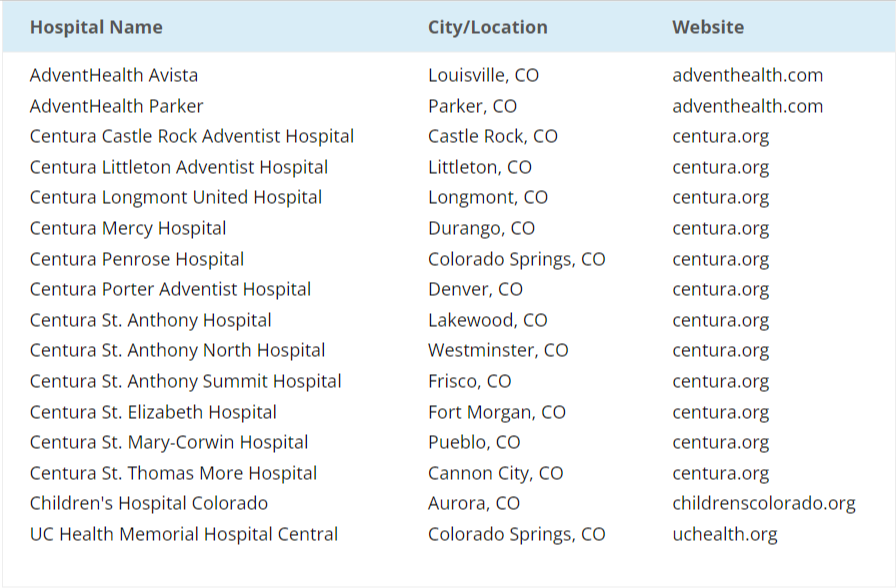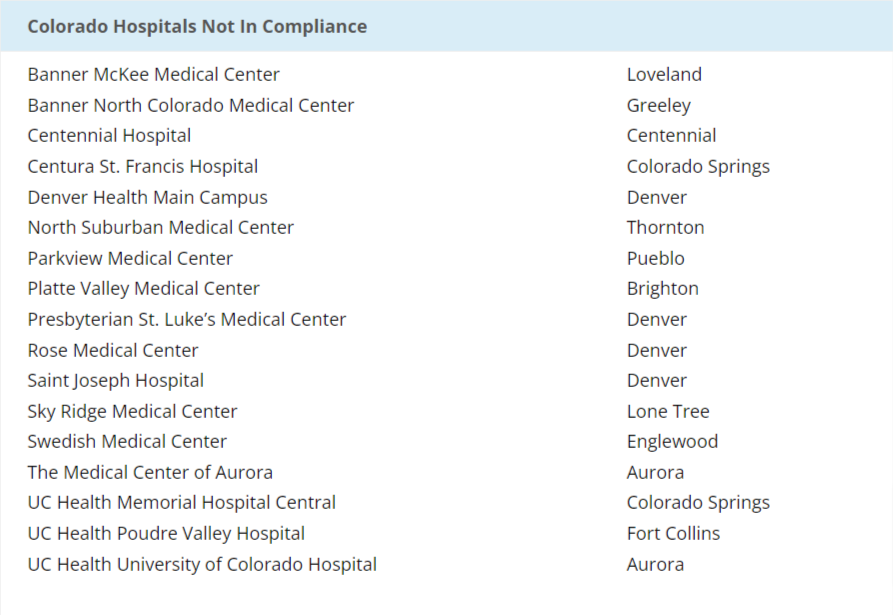It’s been nearly three years since the federal Hospital Price Transparency Rule took effect –– and Colorado hospitals still have not brought themselves into compliance.

That’s the finding of a recent report from PatientsRightsAdvocate.org, a medical consumer advocacy organization.
Background
Beginning January 1st, 2021, the Public Health Service Act required hospitals nationwide to fully disclose their pricing details and publish them in accessible and machine-readable formats on their websites. This is critical information for individuals who wisely want to do research and ensure they’re getting a good value at a competitive price whenever they need to undergo a medical procedure or treatment.
It’s a very basic consumer protection––and not that much to ask. Americans want to know what providers are charging before they schedule medical treatment. Not get a “surprise bill” in the mail after the fact.
But a recent survey showed that up to half of Colorado hospitals are still not in compliance with the law.
 FREE QUOTE
FREE QUOTE
COLORADO HEALTH INSURANCE
What Does The Law Require?
The Hospital Price Transparency Rule
Effective January 1, 2021, hospitals must publicly disclose five types of standard charges: gross charges, negotiated rates per payer, de-identified minimum and maximum negotiated rates, and discounted cash prices, all in a machine-readable format. Additionally, hospitals are required to offer a cost estimator tool or provide payer-specific rates for at least 300 common services.
The law also requires hospitals to clearly publish their discounted prices for cash payers––which typically include health sharing plan members.
Good Faith Estimates
The No Surprises Act mandates that providers give uninsured or self-pay patients a Good Faith Estimate for most scheduled services.
Under the hospital price transparency rules, a Good Faith Estimate (GFE) is a document provided by healthcare providers to uninsured or self-pay patients that outlines the expected costs for medical services.
This requirement aims to enhance transparency and help patients make informed decisions about their healthcare by understanding the potential financial implications before receiving services.
The idea is to protect patients from unexpected and unforeseeable medical costs and to prevent surprise billing, particularly for those who do not have insurance or are seeking care out-of-network.
Just 35 Percent of Hospitals Nationwide are in Full Compliance
According to the Patients’ Rights Advocate February 2024 report, which analyzed more than 2,000 hospital websites nationwide, only about a third of them (689) were fully compliant with federal price transparency laws and regulations.
65.5% of hospitals were not in compliance. ANd 87 hospitals had not posted a usable price menu at all.
And 135 hospitals had actually fallen out of compliance with the law over the six months preceding the February report.
Narrowing things down to Colorado, there is some good news for the Rocky Mountain State: Colorado hospitals are actually doing better than the national average of 34.5% when it comes to complying with federal price transparency rules: 16 out of Colorado’s 32 hospitals – exactly half, were found to be in full compliance.
Here’s a list:
Colorado Hospitals in Full Compliance With Price Transparency Rules
| Hospital Name | City/Location | Website |
|---|---|---|
| AdventHealth Avista AdventHealth Parker Centura Castle Rock Adventist Hospital Centura Littleton Adventist Hospital Centura Longmont United Hospital Centura Mercy Hospital Centura Penrose Hospital Centura Porter Adventist Hospital Centura St. Anthony Hospital Centura St. Anthony North Hospital Centura St. Anthony Summit Hospital Centura St. Elizabeth Hospital Centura St. Mary-Corwin Hospital Centura St. Thomas More Hospital Children's Hospital Colorado UC Health Memorial Hospital Central | Louisville, CO Parker, CO Castle Rock, CO Littleton, CO Longmont, CO Durango, CO Colorado Springs, CO Denver, CO Lakewood, CO Westminster, CO Frisco, CO Fort Morgan, CO Pueblo, CO Cannon City, CO Aurora, CO Colorado Springs, CO | adventhealth.com adventhealth.com centura.org centura.org centura.org centura.org centura.org centura.org centura.org centura.org centura.org centura.org centura.org centura.org childrenscolorado.org uchealth.org |

Each of these hospitals and hospital systems has done the massive amount of work needed to provide consumers with a current, usable price listing of at least 300 medical services provided at their facilities… and in many cases, much more than that.
Furthermore, of the 87 hospitals nationwide that have no usable price transparency data at all, none are in Colorado.
These Colorado hospitals, in contrast, are still not in compliance.
| Colorado Hospitals Not In Compliance | |
|---|---|
| Banner McKee Medical Center Banner North Colorado Medical Center Centennial Hospital Centura St. Francis Hospital Denver Health Main Campus North Suburban Medical Center Parkview Medical Center Platte Valley Medical Center Presbyterian St. Luke’s Medical Center Rose Medical Center Saint Joseph Hospital Sky Ridge Medical Center Swedish Medical Center The Medical Center of Aurora UC Health Memorial Hospital Central UC Health Poudre Valley Hospital UC Health University of Colorado Hospital | Loveland Greeley Centennial Colorado Springs Denver Thornton Pueblo Brighton Denver Denver Denver Lone Tree Englewood Aurora Colorado Springs Fort Collins Aurora |

Of these, the most common reasons for noncompliance are the failure to publish a complete standard charge file and their negotiated rates with different payers/insurance companies.
Each of these Colorado hospitals still has most of the required data posted. And each hospital has published a price estimate tool as well, except for Parkview Medical Center, which isn’t required to.
All Colorado Hospitals listed also have disclosed discounted cash pricing for all services listed as well.
You can download the full report listing some 2000 hospitals nationwide here.
So while nationwide hospitals still have a major problem with compliance, Colorado’s 32 major hospitals and medical centers have a compliance percentage of 50%, which is significantly better than the national average.
However, researchers are still finding gaps in price information for some common medical products and services, such as epi pens – a common and critical service for those experiencing severe allergic reactions/anaphylactic shock.
Why Is Price Transparency Important?
Price transparency is critical for consumers who need to shop around to find the best pricing for needed medical procedures.
Prior to the implementation of hospital price transparency rules, studies showed that hospitals charged wildly different prices from each other, and even charged radically different negotiated prices to different insurance companies within the same hospital.
Hospital executives were fattening up their own bonuses while exploiting the incredibly asymmetrical information environment, taking advantage of the lack of knowledge of ordinary consumers.
In some cases, hospitals have even been caught hiding pricing data from search engines.
Medical services pricing was grossly inefficient. Individual consumers had no real way to shop around different providers, or even get reasonable pricing, in many cases, ahead of actually scheduling the procedure.
Without price transparency, patients had little or no way of identifying and contesting overcharges and billing errors.
The effects of a lack of transparency can be devastating, even for people with insurance.
For example, someone with a Silver-tier health insurance plan could easily need a surgery which costs $75,000.
But Silver-tier plans typically have a 30% co-insurance up to the maximum out-of-pocket limit for the plan, which can be as high as $18,900 as of 2024 for family plans.
Few families have that much cash lying around. But you can significantly reduce your out-of-pocket costs by using price transparency data to find a provider who will do the procedure for much less.
For example, you could use a price transparency comparison tool such as www.healthcarebluebook.com to compare costs at many different providers – even out of state.
“With full transparency, consumers can benefit from competition to make informed decisions, protect from overcharges, billing errors, and fraud, and lower their costs,” said the Patients Rights Advocate report’s authors.
How To Fight For Your Right To Price Transparency
For those looking to take further action, you can file a formal complaint by emailing [email protected].
1.) Compare Costs to Find the Best Value
If you require a medical service, it’s wise to shop around and compare prices. The cost of common procedures and treatments can vary significantly—not only between different regions and cities but even within the same hospital.
Keep in mind that additional expenses like lab work, imaging, or anesthesia may not be included in the standard price lists. Costs can also differ based on whether you’re receiving inpatient or outpatient care. Not being aware of these additional fees can result in a higher-than-expected medical bill.
2.) Ask About Cash Discounts
Many hospitals offer discounts to patients who pay in cash, as this eliminates the need to deal with insurance companies and allows them to retain more of the service fees. Information about cash discounts should be available under the Price Transparency Rule. If it’s not listed online, call the hospital and request the information.
3.) Explore Money-Saving Options
Despite available subsidies, some Affordable Care Act (ACA) health insurance plans remain too costly or restrictive for many people. This highlights the importance of supporting alternative healthcare options, such as Medical Cost Sharing and Health Savings Accounts.
Everyone deserves access to a health plan that suits their needs. Being forced into an unsuitable plan can negatively impact health and infringe on basic rights.
4.) Speak With an HSA For America Personal Benefits Manager
For more information, or to find a more affordable health plan for you and your family, make an appointment to speak with an HSA for America Personal Benefits Manager.
There’s no charge, and our team of seasoned experts can help you save both time and money by matching you with a health plan or combination of solutions that better suits your needs and budget.
 FREE QUOTE
FREE QUOTE
COLORADO COST-SHARING
Conclusion
Things could have been a lot worse for Colorado. Other states are facing much bigger problems, with major hospitals and medical centers failing to make meaningful disclosures for consumers at all.
But Colorado still has some work to do to give consumers and other payers the price transparency information needed to make healthcare more affordable for all of us.
For Further Reading:

Christine Corsini is a health insurance and medical cost sharing expert, and a Personal Benefits Manager at ColoHealth. Her goal is to help people embrace life’s amazing possibilities by staying healthy, saving money, and making the best decisions when it comes to healthcare.




